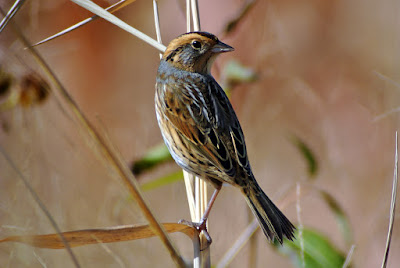"Everywhere you look there is evidence of the enchantment of decay, of a kind of beauty that can only be revealed by a long, slow fading."
― Amitav Ghosh

Pheasant Branch Fall Colors
Although the Wisconsin Fall Color Report indicated otherwise, it seemed to me Dane County reached peak over the weekend. The oak savannah atop the drumlin at Pheasant Branch was popping with striking yellows, oranges, reds, and greens against a dreamy bright blue sky. Within moments upon arrival, I became acquainted with my first avian portraiture subject, a gorgeous Lincoln's Sparrow.

Lincoln's Sparrow
The shy sparrow was only modestly concerned with my presense and evaluated me for threat-level. It would pop-up on a branch, study me for a few seconds, and them resume foraging in the grasses below. Lincoln's Sparrows are a favorite Emberizid –– I love their smart-looking fine stripes and mix of earth-toned plumage features. Dottie Johnson and I sometimes refer to them as Think'n Lincoln's just for fun.
But what is he really think'n? We'll never know, but it's fun to ponder bird cognition.
Naturally, there were plenty of other sparrows on the move over the past week. This immature White-crowned Sparrow posed nicely as a friend of mine stopped to talk to me for a few moments. I said to her "Please excuse me for a moment ― I must photograph this sparrow." Sometimes photographing a bird is utterly effortless, as was the case with this individual. It moved from branch to branch, peering in our direction and gauging intruders in its autumn domain.
White-crowned Sparrow (immature)
Without warning, a pugnacious Song Sparrow decided it needed the elevated view more than the White-crowned Sparrow, charging it off the perch and then looking victorious with its proudly raised crest. Though not quite as endearing as the Lincoln's Sparrow, upon closer study I do find Song Sparrows to be a welcome member of the Emberizid Parade. Though most of the sparrows that visit the prairie this time of year will continue to travel south, a small number of Song Sparrows will endure our harsh winter season.
Without warning, a pugnacious Song Sparrow decided it needed the elevated view more than the White-crowned Sparrow, charging it off the perch and then looking victorious with its proudly raised crest. Though not quite as endearing as the Lincoln's Sparrow, upon closer study I do find Song Sparrows to be a welcome member of the Emberizid Parade. Though most of the sparrows that visit the prairie this time of year will continue to travel south, a small number of Song Sparrows will endure our harsh winter season.

The highlight of the weekend came in the form of orange sparrows. I saw on eBird that Steve Thiessen found a couple of Nelson's Sparrows at the Vera and Marshall Browne Prairie just northwest of Goose Pond. Though there have been decent reports of this species at Lake Barney, the Goose Pond area is a favorite fall destination. My birding posse and I were astonished to find over a dozen of these charming little sparrows along the edge of the large pond there ― I have never seen so many at one location. It was fun watching them scurry along the the dense vegetation of the pond's mudflats where there was plenty of smartweed and other food sources.

Nelson's Sparrow

There were also several large flocks of Pine Siskins foraging on various prairie plants for seeds. Here in southern Wisconsin as in other places, we're seeing a huge uptick (irruption) of siskins this fall. Apparently, conditions to our north are less than ideal for overwintering, prompting the finches and other birds to head south for better foraging opportunities. We've been experiencing an irruption of Red-breasted Nuthatches as well.

Pine Siskin
And so another beautiful and bountiful fall weekend of Nature Study came to an end. In the coming days we'll see more Fox Sparrows, Dark-eyed Juncos, and American Tree Sparrows should be arriving soon. I have already observed a few flocks of Lapland Longspurs at various locations in Dane and Iowa Counties. What else with the forthcoming winter bring down from the boreal forests? It'll be interesting to see if there will be an owl irruption. But for now I'll be content observing fall's glorious enchantment of decay.











